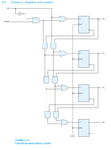Eli_221B
Newbie level 4
hello every one:wink: I have serious problems in writting vhdl structural 4 bit up/down binary counter code by 4 t flip flops.... this is my first code Im so confused and havent enough time. please help and guide me to learn and edit it . thank you so much


Code VHDL - [expand]
Last edited by a moderator:

